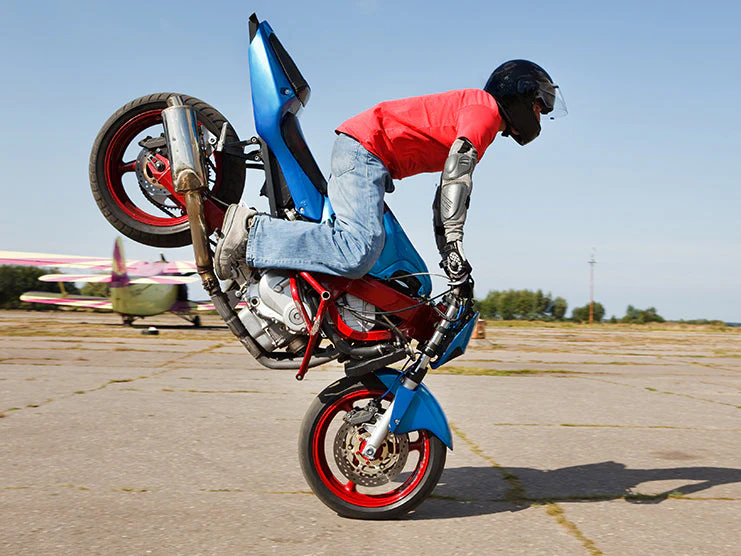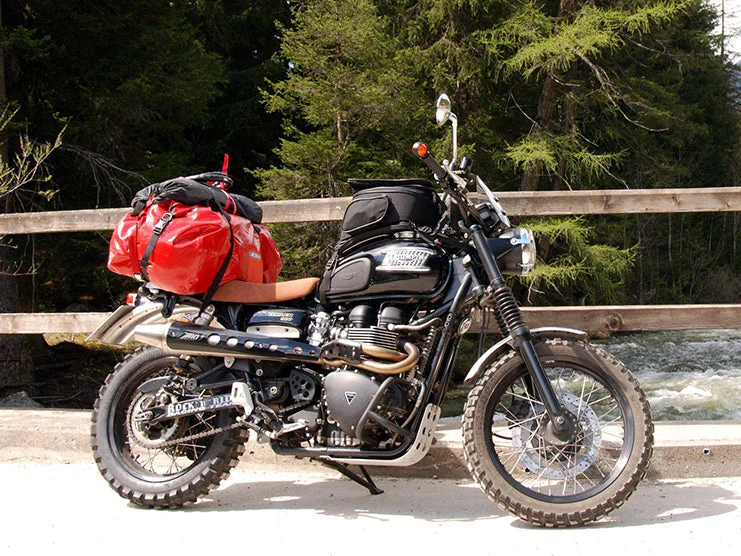Table of Content
Motorcycles are reliable means of transportation. Some riders use their motorbikes for daily commutes, work, weekend rides, and motorcycle tours. Meanwhile, other riders use motorcycles to perform acrobats or stunts. Not everybody can perform motorcycle stunts. Stunt riders receive training at institutes where they learn how to maintain control of their motorcycles, practice acrobatics, and shift between body positions. Read this article to learn how to become a stunt rider.
1. Choose the Right Motorcycle
Only a few specific motorcycles can be used to perform stunts. They must be lightweight, produce adequate horsepower, and accelerate quickly. The most popular type of motorcycle used for stunting is the naked bike due to being light, agile, and torquey. However, most professional stunt riders use customized motorcycles to perform stunts.
There is no need to buy an expensive motorcycle powered by a massive engine if you want to learn how to perform stunts. A motorcycle with a 300 cc engine is an adequate stunt vehicle. However, it must have good suspensions, throttle response, clutch, and brakes to ensure better control while stunting. Stunting requires controlling the engine power output, engaging the clutch at the right time, and using the front and rear brakes to skid. Start with a cheap, easy-to-ride, robust motorcycle with long-wheel travel suspension, like a dirt bike.
After choosing the right motorcycle, you must make several modifications to make it suitable for stunts. Nowadays, trained and experienced motorcyclists can perform stunts on almost every motorbike. However, it is recommended to use only customized motorcycles to ensure safety and reduce the risk of damage in case you lose control of your motorbike while performing stunts.
Also Read: 9 BEST MOTORCYCLES FOR STUNTS
2. How to Modify Your Motorcycle for Stunts
Listed below are modifications you must make to your motorcycle to improve performance and reduce the risk of serious damage during a:
2.1 Frame Sliders

Frame sliders protect the motorcycle fairings and frame from damage. They extend along both sides of the motorcycle, coming in contact with the ground first during a crash to minimize damage to the motorcycle. Frame sliders can also provide some protection for motorcyclists. However, they are not as effective as a frame, engine guard, or cage since most parts are still exposed and prone to damage during a motorcycle crash.
2.2 Crash Cages

Crash cages protect the engine parts, transmission, engine mounts, frame, and fairings during crashes. While modifying your motorcycle for stunt riding, you must also be careful not to increase its weight significantly.
2.3 Sub-Cages

Sub-cages protect the rear frame and motorcycle parts that the crash cages do not cover.
2.4 Hand Brake
There are several stunts where riders cannot press the rear brake pedal. For example, while performing a high chair and spreader, the rider’s legs are nowhere near the rear brake pedal. To perform such stunts safely, the hand brake is installed as an alternative way to engage the rear brake.
2.5 12 O’Clock Bar

The 12 o’clock bar protects the rear end from becoming scratched while performing a front wheelie. This tail extension attached to the rear end helps the motorcycle stay perfectly vertical while performing a wheelie.
2.6 Round Bars

A round bar has the same function as a 12 o’clock bar, except that it has a curved shape. A stunt rider can perform circle wheelies with a round bar installed at the rear of the frame.
2.7 Sprocket Kit for Stunts

Most stunts require shifting gears, engaging the clutch, and opening and closing the throttle. To perform a wheelie at slow speeds, a motorcycle must have rear sprockets with 55-66 teeth to ensure quick power delivery even at slow speeds.
3. Start with the Basics
To become a stunt rider, you must have good riding skills. If you know how to operate a motorcycle, including how to shift gears and engage the clutch, you are in a good position to try stunt riding. It is best to start mastering the basics rather than immediately try to start copying expert stunt riders. Work on your riding skills, including how to gain full control of your motorcycle and lean without falling over.
4. Learn from Experienced Stunt Riders
To learn stunt riding, you can follow professional stunt riders on social media and YouTube and watch the content they upload. You can also find stunt riding lessons to help you master specific stunts. Professional stunt riders you can follow on social media and YouTube include:
4.1 Aaron Calton
| Aaron Calton - A Professional Stunt Rider | |
|---|---|
| Country | America |
| Stunting Style | Freestyle |
| Started Stunting | At the Age of 14 |
| Achievement | Youngest Stunt Riding Champion At the Age of 15 |
| Works For | Team Red Bull |
4.2 Sarah Lezito
| Sarah Lezito - A Professional Stunt Rider | |
|---|---|
| Country | France |
| Stunting Style | Freestyle |
| Performed In | Several Shows Around the World |
| Works For | Worked as a Stunt Double of Scarlett Johansson in Avengers: Age of Ultron |
4.3 Rok Bagoros
| Rok Bagoros - A Professional Stunt Rider | |
|---|---|
| Country | Slovenia |
| Stunting Style | Freestyle |
| Performed In | MotoGP Bull Air Race |
| Works For | KTM Also Worked as a Stunt Double |
5. Wear Safety Gear
For stunt riding, you will be required to wear a DOT-approved helmet, protective gloves, jacket, pants, motorcycle boots, elbow pads, and knee pads to reduce the risk of severe injuries in case you fall off your motorcycle while performing stunts.
6. Start Practicing at an Empty Parking Lot
Find an empty parking lot or an open space where it is safe to perform stunts. Make sure your motorcycle has all the parts necessary to perform specific stunts.
7. Start with Common and Easy Stunts for Beginners
7.1 Wheelie
The most common motorcycle stunt is the wheelie. Every stunt rider starts by learning how to do a wheelie. The wheelie involves lifting the motorcycle's front wheel and riding only on the rear wheel.
How to Perform a Wheelie
- Turn on your motorcycle
- Quickly open the throttle while abruptly releasing the clutch
- Lean back as the front wheel is lifted
- Control the throttle output while holding the clutch
- Balance your motorcycle on the rear wheel.
Also Read: THE PROS & CONS OF DOING MOTORCYCLE WHEELIES
7.2 Burnout
A burnout is when the motorcycle’s wheels spin while its frame remains in place, producing a cloud of smoke. To perform this stunt correctly, your motorcycle must have reliable brakes.
How to Perform a Burnout
- Turn on your motorcycle
- Engage the clutch
- Put the motorcycle into first gear
- Put weight on the front suspension by adjusting your weight toward the front
- Apply the front brake by pressing the brake lever
- Start opening the throttle and gradually releasing the clutch at the same time
| Note: A burnout may not destroy the clutch, but it can cause the rear tire to become worn out more quickly. Do not perform burnouts often if you also use your motorcycle for daily commutes. |
7.3 Rolling Burnout
A rolling burnout is a slightly advanced form of a basic burnout. Though simple, this stunt requires you to ride at a low speed.
How to Perform a Rolling Burnout
- Turn on your motorcycle
- Start riding at a very low speed
- Stand straight on the footpegs
- Put weight on the front suspension by leaning forward
- Press your knees against the fuel tank
- Press the front brake lever while accelerating
- During the burnout, the rear tire may start to roll to and fro
- Use your handlebars to countersteer
- If your rear wheel keeps spinning, shift your motorcycle into second gear
7.4 Donut
A donut is like a rolling burnout, except the motorcycle moves in a circle instead of a line.
How to Perform a Donut
- Turn on your motorcycle
- Start riding at a very low speed
- Stand straight on the footpegs
- Put weight on the front suspension by leaning forward
- Press your knees against the fuel tank
- Press the front brake lever while accelerating
- Use your handlebars to countersteer
- Push the handlebars in the opposite direction to move in a circle
7.5 Stoppie
If you are a beginner, start with a basic stoppie. Do not ride your motorcycle at high speed while trying to perform a stoppie. Start practicing a stoppie at 10-15 mph. As you gain experience, start gradually increasing the motorcycle’s speed while performing a stoppie. Your motorcycle must have good brakes to perform a stoppie.
How to Perform a Stoppie
- Reduce the front tire pressure to 20 psi
- Turn on your motorcycle
- As you reach a speed of 10-15 mph, pull the clutch lever and quickly press the front brake lever
- This will cause the motorcycle's front wheel to stop immediately, causing the rear wheel to lift in the air
- If your rear wheel lifts too much, do not hold onto the front brake; release the brake to allow the front wheel to spin.
8. Enroll in a Motorcycle Stunt Riding Course
There are training institutes that offer stunt riding courses where you can learn how to perform stunt riding safely. These institutes are good for beginners who want to start stunt riding.
9. The Bottom Line
Learning to become a motorcycle stunt rider can be fun. However, stunt riding can have several safety risks if you have poor technique or are untrained. You must possess steady control and handling to perform motorcycle stunts. If you want to become a stunt rider, make sure you have learned the basic motorcycle riding skills first. If you need guidance, there are several professional stunt riders you can follow on social media.
Make sure to wear safety gear, keep practicing in empty parking lots, attend a training institute, and start with the most common and easiest motorcycle riding stunts. Choose a motorcycle that you can handle and can be fitted with the necessary add-ons mentioned in this article. That being said, if you are the type of rider who loves to go on long-distance trips and motorcycle tours, you should install a fairing, sissy bar, backrest, crash bar, tank bag, saddlebags, and pulled-back handlebars.












Leave a comment
All comments are moderated before being published.
This site is protected by hCaptcha and the hCaptcha Privacy Policy and Terms of Service apply.